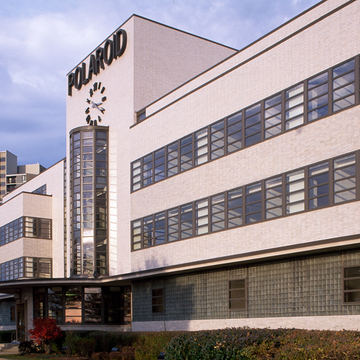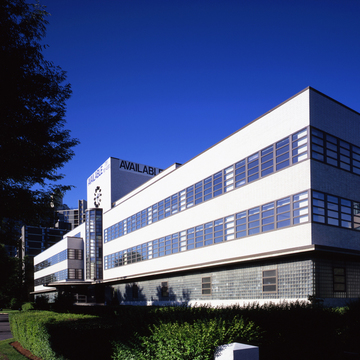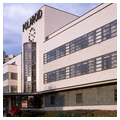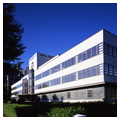You are here
The Landmark (Boston Blacking Chemical)
Originally designed for Boston Blacking Chemical Company, a subsidiary of United Shoe Machinery Company, for its experimental work in developing and testing new products, the building was occupied as a laboratory by Polaroid from 1966 to 1996, when the company transformed the factorylike interior spaces into its corporate headquarters.
The classically organized flat-roofed building breathes the language of modernism when the International Style was in its youth. The bisymmetrical disposition of the lateral wings has horizontal window bands throughout, alternating with glazed white brick speckled with magnesium and laid in a double Flemish bond. Depression years called for such economy measures as the use of brick on the rear. Cantilevered eaves (surmounted by the second and third stories) continue along the sides and into a semi-circular bow and canopy at the main convex glass brick bay entrance, accentuated by a vertical three-story window that bears aspects of Art Deco. Initially the logo in stainless steel sans serif font announced the company above a clock, still extant.
The recent renovation consists of a four-story addition in the middle of the rear elevation containing a reception area, fire staircase, conference rooms, and library. The design is in harmony with the original building, as are the twin structures on either side forming a central court with parking lot. The plan remains Beaux-Arts, the aesthetic International Style industrial. The building at 780 Memorial Drive houses Infinity Pharmaceutical; 790 Memorial Drive includes the Science Hotel at Cambridge and sundry pharmaceutical companies (both these buildings are not on Memorial Drive even though they bear their addresses). Behind the complex at numbers 157, 165, and 173 Pleasant Street, Harvard-owned low-rise housing, designed by Mark Boyes-Watson for the Alexandria Co., in 1997, imitate the wooden vernacular of Second Empire domestic architecture.
Writing Credits
If SAH Archipedia has been useful to you, please consider supporting it.
SAH Archipedia tells the story of the United States through its buildings, landscapes, and cities. This freely available resource empowers the public with authoritative knowledge that deepens their understanding and appreciation of the built environment. But the Society of Architectural Historians, which created SAH Archipedia with University of Virginia Press, needs your support to maintain the high-caliber research, writing, photography, cartography, editing, design, and programming that make SAH Archipedia a trusted online resource available to all who value the history of place, heritage tourism, and learning.





